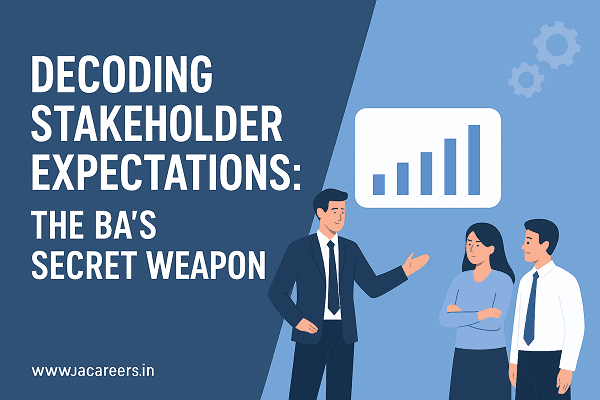Introduction
Every successful project begins with one thing — clear stakeholder expectations.
Yet, this is where most projects fail. Misunderstood goals, unspoken assumptions, and conflicting priorities often lead to frustration and rework.
For a Business Analyst (BA), understanding and managing stakeholder expectations is not just a task — it’s an art form. It requires empathy, communication, analysis, and influence. In this article, we’ll explore how BAs decode expectations, align priorities, and deliver successful outcomes through real-world examples and best practices.
🔍 The Invisible Wall: Why Expectations Crash Projects
Many projects start strong but fail midway — not because of poor technology, but because of mismatched expectations.
Imagine this:
A retail company wants a “simple e-commerce site.” The stakeholder assumes that includes inventory tracking, order management, and customer analytics. The BA documents only the shopping cart and payment gateway. When the system goes live, the stakeholder says, “That’s not what I wanted!”
This invisible wall of miscommunication causes:
Scope creep: new requirements keep getting added.
Missed deadlines: unclear priorities cause delays.
Budget overruns: changes mid-project increase costs.
👉 Real-time BA Scenario:
During a project at a financial firm, a BA discovered that two departments defined “customer” differently — one meant “account holder,” the other meant “end user.” By facilitating a discussion early, the BA avoided months of confusion and costly data mapping errors.
Business Analyst’s Role:
Clarify ambiguous requirements.
Align different stakeholder interpretations.
Document clear, measurable expectations.
For more on avoiding requirement gaps, explore our article on Effective Requirement Elicitation Techniques.
🕵️♀️ Unmasking the Stakeholder: Beyond the Job Title
A successful BA knows that not all stakeholders are obvious.
Some are vocal, while others — like end users or support teams — quietly hold critical insights.
How BAs Identify Stakeholders
Primary stakeholders: directly affected (e.g., customers, users).
Secondary stakeholders: indirectly affected (e.g., IT support, finance).
Key influencers: senior managers or regulators who shape decisions.
Pro Tip: Use a Stakeholder Matrix to map influence vs. interest.
High influence + high interest = engage regularly.
Low influence + high interest = inform periodically.
👉 Real-time BA Scenario:
In a healthcare project, the BA initially worked only with doctors and administrators. Later, a nurse pointed out that certain software screens were not usable during emergencies. Including her perspective led to a safer, faster interface.
Business Analyst’s Role:
Identify both direct and indirect stakeholders.
Recognize hidden influencers.
Build trust through consistent communication.
Learn more about stakeholder engagement from our detailed post:
Stakeholder Engagement Strategies
🎯 The Art of Extraction: Asking the Right Questions
Once stakeholders are identified, the BA’s next mission is to uncover what they truly mean, not just what they say.
How BAs Extract Expectations
Ask open-ended questions:
“What does success look like for you?”
“What problem are we trying to solve?”
“What would make this project a failure?”
Follow up with active listening:
Paraphrase to confirm understanding.
Use mirroring: “So, you’re saying you’d like the system to…”
Capture non-verbal cues and tone.
Visual Communication Matters
Often, words are not enough.
Flowcharts, mock-ups, and storyboards help stakeholders visualize their expectations.
👉 Real-time BA Scenario:
A BA in an Agile team used a clickable prototype to demonstrate how a loan application portal would look. Stakeholders instantly realized their initial requirement missed a key step — “document upload.” Catching that early saved weeks of rework.
Business Analyst’s Role:
Facilitate requirement-gathering workshops.
Translate vague inputs into clear, testable requirements.
Use visuals and user stories to ensure shared understanding.
To learn how to write clear user stories, visit our guide on User Story Writing Best Practices.
⚖️ Decoding the Noise: Prioritization & Conflict Resolution
Not all expectations are equal — and some will conflict.
A BA must prioritize requirements and mediate differences without bias.
Common Prioritization Techniques:
MoSCoW Method: Must, Should, Could, Won’t.
Weighted Scoring: Assign scores based on business value, risk, and cost.
100-point voting: Stakeholders distribute “points” across features to indicate importance.
Conflict Resolution Techniques:
Focus on business objectives, not personal preferences.
Use data-driven reasoning — e.g., ROI, compliance needs.
Act as a neutral facilitator — ensure every voice is heard.
👉 Real-time BA Scenario:
In an e-commerce project, marketing wanted flashy animations; IT wanted faster load times. The BA facilitated a discussion highlighting how page speed affects conversion rates — leading to a compromise that balanced both needs.
Business Analyst’s Role:
Ensure fairness and objectivity in decisions.
Maintain focus on organizational value.
Use analysis techniques to justify trade-offs.
For more tools and techniques, explore Business Process Modeling Techniques.
🧩 Your Secret Weapon: The Expectation Alignment Blueprint
To tie it all together, here’s your Expectation Alignment Blueprint — a step-by-step approach for every BA.
Step-by-Step Blueprint:
Identify all stakeholders — direct, indirect, and hidden influencers.
Understand their needs, wants, and pain points.
Ask open-ended questions to reveal assumptions.
Visualize expectations through diagrams or prototypes.
Prioritize requirements using structured techniques.
Facilitate consensus and resolve conflicts neutrally.
Document agreements clearly in BRDs or user stories.
Communicate frequently to manage changes in expectations.
👉 Example in Action:
A BA working on a banking CRM project used this blueprint to align multiple departments — sales, operations, and compliance. The result? Reduced rework by 35% and improved stakeholder satisfaction scores by 25%.
Business Analyst’s Role:
The BA acts as the bridge between business vision and technical execution — ensuring what’s delivered truly meets the intended goals.
🧠 Conclusion
Decoding stakeholder expectations isn’t just a soft skill — it’s a core competency that defines a successful Business Analyst.
By asking the right questions, using visual tools, and prioritizing effectively, BAs ensure smoother communication, fewer misunderstandings, and greater project success.
Remember: Projects don’t fail because of bad technology — they fail because of unspoken expectations. And that’s exactly what a skilled Business Analyst prevents.
Related Articles

Business Analyst , Functional Consultant, Provide Training on Business Analysis and SDLC Methodologies.



Great article, thank you for sharing these insights! I’ve tested many methods for building backlinks, and what really worked for me was using AI-powered automation. With us, we can scale link building in a safe and efficient way. It’s amazing to see how much time this saves compared to manual outreach. https://seoexpertebamberg.de/
Great article, thank you for sharing these insights! I’ve tested many methods for building backlinks, and what really worked for me was using AI-powered automation. With us, we can scale link building in a safe and efficient way. It’s amazing to see how much time this saves compared to manual outreach. https://seoexpertebamberg.de/